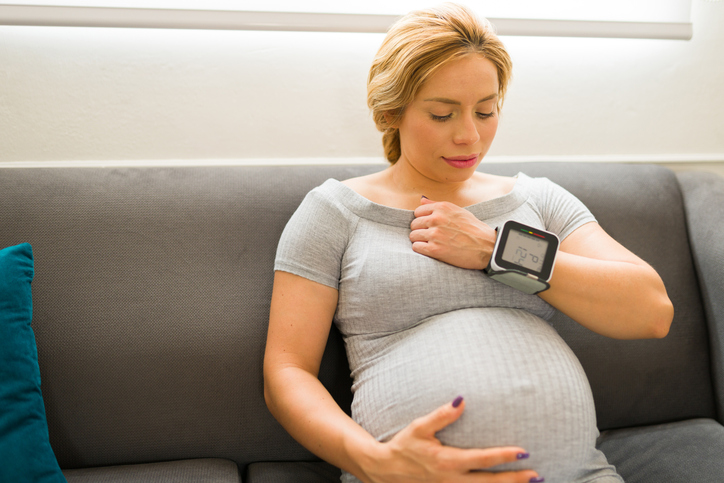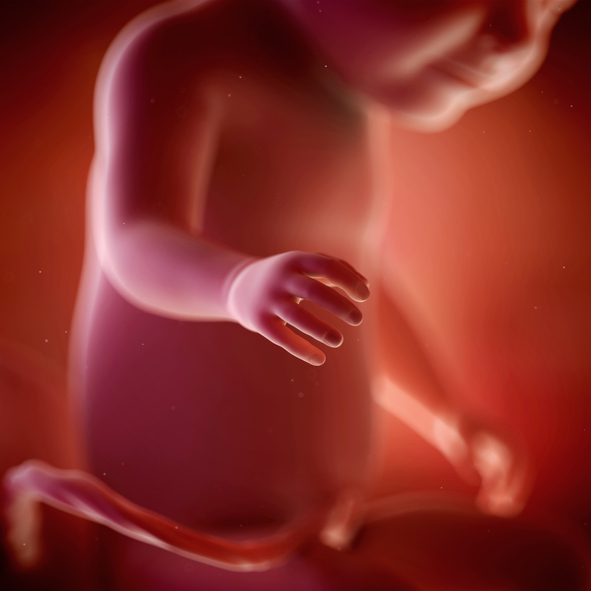HELLP Syndrome in Pregnancy: Causes & Treatment Options

Many of us are familiar with preeclampsia, one of a number of hypertensive disorders that affect pregnant people. However, you might not have heard about HELLP Syndrome.
HELLP Syndrome is a severe form of preeclampsia that doesn’t always have the same symptoms as classic preeclampsia. For this reason, it’s sometimes overlooked or misdiagnosed. And that can be deadly for you and your baby.
Learn how to recognize the symptoms of HELLP Syndrome, and what you can do to increase your chances of a healthy pregnancy.
Related: Risks of Multiple Pregnancy: High Blood Pressure
What is HELLP Syndrome?
HELLP Syndrome is a blood and liver disease that many consider to be a severe form of preeclampsia. Like preeclampsia, HELLP typically manifests in the third trimester of pregnancy.
HELLP stands for Hemolysis, Elevated Liver enzymes, and Low Platelet count.
Hemolysis (microangiopathic hemolytic anemia) refers to the rupture of red blood cells and the spilling of their contents into the surrounding fluid.
LDH (lactate dehydrogenase) and AST (aspartate aminotransferase) are enzymes that are affected by HELLP. The liver produces AST in low quantities, while LDH is found in almost every cell and organ of the body. When cells are damaged, they release LDH into the bloodstream.
Elevated AST can mean that the liver is damaged. Elevated levels of LDH may indicate disease or damage to the tissues.
Platelets (thrombocytes) are colorless blood cells that help blood clot. Blood clotting stops bleeding by forming clumps that plug up blood vessel injuries. Low platelet count (thrombocytopenia) can lead to prolonged or excessive bleeding.
Categories of HELLP
There are three categories of HELLP:
- Class I (the most severe): AST greater than or equal to 70 IU/L, LDH greater than or equal to 600 IU/L, and platelets less than 50,000/uL
- Class II (moderate): AST greater than or equal to 70 IU/L, LDH greater than 600 IU/L, and platelets between 50,000/uL and 100,000/uL
- Class III (mild): AST greater than or equal to 40 IU/L, LDH greater than 600 IU/L, and platelets between 100,000/uL and 150,000/uL
What is the Difference Between HELLP and Preeclampsia?
HELLP is a severe form of preeclampsia. It’s also, thankfully, rarer than preeclampsia. Preeclampsia affects five to eight percent of pregnant people, and out of those, 10 to 20 percent may develop HELLP. That’s about one percent of all pregnancies.
Preeclampsia and HELLP Syndrome share some symptoms, like severe headaches, edema, and swelling of the hands and face. Other symptoms, like shoulder and chest pain, are particular to HELLP. Some HELLP symptoms are also symptoms of other problems, such as influenza, viral hepatitis, and gastroenteritis, and are therefore sometimes misdiagnosed.
People with HELLP may not exhibit some of the hallmark symptoms that define preeclampsia, such as high blood pressure and proteinuria. HELLP is defined, instead, by hemolysis, low platelet count, and high levels of liver enzymes.
HELLP is also more dangerous than ordinary preeclampsia, with a fatality rate as high as 24 percent (Khalid et ali, 2023).
What are the Symptoms of HELLP Syndrome?
HELLP shares some symptoms with classic preeclampsia. However, other hallmark symptoms, such as protein in the urine and hypertension, may be absent altogether. Still other symptoms may be misdiagnosed as unrelated conditions.
In order to be considered HELLP, three symptoms must be present: low platelet count, hemolysis, and elevated liver enzymes.
Other symptoms may include:
- Sudden weight gain
- Swelling of face and/or hands
- Edema (fluid retention)
- Malaise, or feeling unwell
- Epigastric (abdominal) pain
- Chest pain or tenderness
- Upper right side pain (from liver distention)
- Shoulder pain
- Pain while breathing, shortness of breath, difficulty breathing, or gasping for air
- Vision changes such as double vision, blurred vision, flashing lights, or auras
- Headaches that won’t go away, even with medication
- Nausea, indigestion, or vomiting with pain after eating
Many of these are symptoms of other problems. However, as HELLP Syndrome can be life-threatening, it’s important to contact your healthcare provider if you experience them.
How is HELLP Syndrome Diagnosed?

If your healthcare provider suspects you’re suffering from HELLP Syndrome, they may perform a physical exam. They may check your blood pressure. They may also feel for tenderness in the abdomen, liver enlargement, and other types of swelling.
Your doctor may also order various tests, including:
- Blood tests to check liver function and liver enzymes, red blood cell count, and platelet levels
- A urine dipstick test to look for protein in the urine
- An MRI to check for bleeding in the liver
What Causes HELLP Syndrome in Pregnancy?
Nobody quite knows why some pregnant women develop HELLP Syndrome, but some people believe it has to do with abnormal development of the placenta.
People who experience or have a family history of preeclampsia are more likely to experience HELLP in subsequent pregnancies. There are numerous other risk factors, which we’ll discuss in greater detail below.
Can you have HELLP Syndrome Postpartum?
Yes. Although most cases of HELLP will resolve within 48 hours of delivery, HELLP can develop in the days or even weeks after delivery, even if the pregnancy itself was not high-risk.
Who is at Risk for HELLP Syndrome?
The exact cause is not known, and developing HELLP is nobody’s fault. However, there are a few things that may increase a person’s chance of developing HELLP (Chi, 2018; BMJ Best Practice, 2022; Khalid et ali, 2023).
Risk factors include:
- African American ancestry
- White ancestry
- Being pregnant with more than one baby
- Being over 35 or under 20 years of age
- History or family history of preeclampsia
- Previous pregnancies
- Various autoimmune disorders, especially antiphospholipid syndrome
- Existing metabolic disorders
- Having a clotting disorder
- Obesity
- Having had preeclampsia in a previous pregnancy
- Existing diabetes or kidney disease
- Having high blood pressure
- Having COVID-19 during pregnancy
Is HELLP Syndrome Life-Threatening?
Yes. The morbidity rate of HELLP syndrome can be as high as 24 percent. That’s a bit more than twice as high as the case fatality rate for SARS (11 percent), and more than 20 times higher than the CFR for COVID-19 (1 percent).
Serious Complications of HELLP Syndrome
HELLP can lead to some very serious complications for the pregnant person, including:
- Renal failure (kidney failure)
- Liver rupture
- Respiratory failure
- Pulmonary edema (fluid in the lungs)
- Placental abruption (detachment of the placenta from the uterus before the baby is born)
- Hemorrhage (excessive bleeding) during delivery
- Disseminated intravascular coagulation, or DIC (formation of blood clots throughout the body, which block small blood vessels)
- Thrombotic thrombocytopenic purpura
- Subscapular liver hematoma (Grigorakis, 2022)
- Stroke
- Death
Does HELLP Syndrome Affect the Baby?
Yes.
As with preeclampsia, the treatment for HELLP Syndrome is delivery. Often, this means early delivery, sometimes before the baby’s lungs are developed enough to breathe in the outside world. The baby may require time in a neonatal ICU unit or other treatments before he or she is able to go home.
If a baby weighs more than two pounds (1000 grams) at the time of delivery, its chances of survival and long-term good health are equal to those of non-HELLP babies of the same weight. For babies under this weight, however, the chances of a positive outcome are much less (Preeclampsia.org, 2023).
HELLP also increases the chances of stillbirth to 51 out of every 1,000 births. Infant death rates from HELLP-related conditions such as placental abruption, placental failure with intrauterine asphyxia, and extreme prematurity range from 7.7 percent to 60 percent.

Treatment for HELLP Syndrome
Before 34 weeks of pregnancy, your doctor may recommend some measures to protect you and your baby. These may include:
- Magnesium sulfate, which can help to prevent seizures
- Blood pressure medication
- Blood transfusions to treat low platelet levels and anemia
- Corticosteroid medication, which will help your baby’s lungs to develop more quickly in case an early delivery is needed
If your baby is of a gestational age where it has a good chance of survival outside the womb— generally more than 34 weeks gestation —your obstetrician may want to deliver early, possibly by cesarean section.
After delivery, your doctor may continue antihypertensive treatments (magnesium sulfate, high blood pressure medication) until the symptoms resolve.
How to Reduce Your Chances of Developing HELLP Syndrome
Because the causes of HELLP are unknown at this time, there aren’t any sure ways of preventing it. However, you can take steps to reduce your number of risk factors.
Maintaining a healthy lifestyle can go far toward increasing your chances of a healthy pregnancy overall (Chi, 2018). A healthy lifestyle includes:
- Exercising regularly
- A diet rich in fiber, fruits, vegetables, lean protein, and whole grains
- Not smoking or vaping
Diet and exercise can decrease your chances of developing diabetes and high blood pressure, both of which are risk factors for HELLP Syndrome. And if you have either of these conditions, a heart-healthy lifestyle can help you to reduce their effects.
Smoking and vaping can increase blood pressure and heart rate, and can also increase your chances of blood clots and kidney failure (British Heart Foundation, 2023), not to mention harm your baby. So if you smoke or vape, stop.
In addition to looking after your health, regular prenatal care visits can help your doctor to detect and treat problems early.

